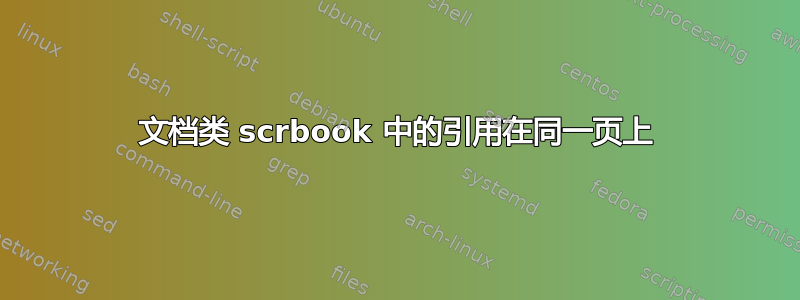
我在论文中使用了 document class scrbook,参考书目放在最后。我希望使用 cite 的引用与我引用的引用位于同一页(类似于脚注文本)。我尝试了所有方法,但无法将 documentclass scrbook 更改为其他内容。有没有办法让引用的参考书目位于同一页?
%%%%%%%%%%%%%%%%%%%%%%%%%%%%%%%%%%%%%%%%%%%%%%%%%%%%%%%%%%%%%%%%%%%%%%%%%%%%
% Format of the dissertation
\documentclass[12pt,numbers=noenddot,headings=normal, headsepline, a4paper, pdftex,bibtotoc,openany]{scrbook}
%\usepackage[english]{babel}
%\usepackage[utf8]{inputenc}
%\usepackage[backend=biber]{biblatex}
%\usepackage{cite}
%\usepackage[backend=bibtex,natbib,style=authoryear]{biblatex}
%\usepackage[a4paper, inner=2.3cm, outer=3.2cm, top=3cm, bottom=3.5cm]{geometry}
%\usepackage[autocite=footnote,notetype=foot+end,style=authortitle-ibid]{biblatex}
%\usepackage[a4paper]{geometry}
%\usepackage{a4wide}
\hyphenation{resi-dual-based}
%\usepackage{natbib}
%\usepackage{biblatex}
%\usepackage[style=verbose-ibid,backend=bibtex]{biblatex}
%\usepackage[autocite=footnote,notetype=foot+end,style=authortitle-ibid]{biblatex}
%\bibliography{references}
%\RequirePackage{biblatex}
\pagestyle{headings}
\let\tmp\oddsidemargin
\let\oddsidemargin\evensidemargin
\let\evensidemargin\tmp
\reversemarginpar
% something for Umlauts
\usepackage[T1]{fontenc}
% use timew new roman as the default font ... no
%\usepackage{mathptmx}
%\usepackage{enumitem}
%\usepackage{biblatex}
%\renewcommand*{\bibfont}{\footnotesize}
% Mathematical symbols
\usepackage{amsmath}
\usepackage[official]{eurosym} %added
\usepackage{amssymb}
\usepackage{amsthm}
\usepackage{epstopdf}
\usepackage{pgfplots}
\usepackage{stmaryrd}
\usepackage{bbm}
\usepackage{graphicx}
\usepackage{floatrow}
\usepackage[pdftitle={Dissertation}, bookmarksopen=false, pdfauthor={G}, pdfstartview=FitH, hidelinks]{hyperref} %hidelinks used to remove the ugly red boxes
\usepackage[onehalfspacing]{setspace}
\usepackage{fancyhdr}
\usepackage{makeidx}
%\usepackage{subcaption}% added
\usepackage{subfig}% Added to have figures side-by-side
\renewcommand\thesubfigure{\roman{subfigure}} % change numbering of figure to roman i, ii ...
%\usepackage{slashbox}
%added long table for table longer than a page
%\usepackage{longtable}
%\usepackage{color}
\usepackage{xcolor} % added
\colorlet{shadecolor}{blue!20}
%\usepackage{framed, xcolor} % added
\usepackage{colortbl}% http://ctan.org/pkg/colortbl %added
\usepackage{appendix}
\usepackage{subfig}
%\usepackage{subfigmat}
\usepackage{booktabs}
%\usepackage{transparent}
\usepackage{multirow}
\renewcommand{\appendixname}{Appendix}
\usepackage[version=3]{mhchem}
%\usepackage{subcaption}
\usepackage{siunitx}
\usepackage{rotating} % to allow for sidewaystables
\usepackage{verbatim} % to allow for comments
\DeclareSIUnit\calorie{cal}
\usepackage{xargs} %added
\usepackage{lipsum}%added
%\usepackage{pgf-pie} % added
%\usepackage{footbib}
%\bibliographystyle{kluwer}
\newcommandx{\unsure}[2][1=]{\todo[linecolor=red,backgroundcolor=red!25,bordercolor=red,#1]{#2}}
\newcommandx{\change}[2][1=]{\todo[linecolor=blue,backgroundcolor=blue!25,bordercolor=blue,#1]{#2}}
\newcommandx{\info}[2][1=]{\todo[linecolor=OliveGreen,backgroundcolor=OliveGreen!25,bordercolor=OliveGreen,#1]{#2}}
\newcommandx{\improvement}[2][1=]{\todo[linecolor=Plum,backgroundcolor=Plum!25,bordercolor=Plum,#1]{#2}}
\newcommandx{\thiswillnotshow}[2][1=]{\todo[disable,#1]{#2}}
%added
\usepackage[printonlyused]{acronym}%added
\newenvironment{abstract}{\rightskip1in\itshape}{} %added
\usepackage{scrextend} %added
%\usepackage[round]{natbib}
\usepackage{algorithm}% http://ctan.org/pkg/algorithms %added
\usepackage{algpseudocode}% http://ctan.org/pkg/algorithmicx %added
\usepackage{pdflscape}%added
\usepackage{pdfpages}%added
\usepackage{float}%Added to keep figure within the section where it was mentioned
\usepackage{booktabs} %added to create nice table
%\usepackage{jurabib}
%added from here till the new command ending
\colorlet{tableheadcolor}{gray!25} % Table header colour = 25% gray
\newcommand{\headcol}{\rowcolor{tableheadcolor}} %he
\colorlet{tablerowcolor}{gray!10} % Table row separator colour = 10% gray
\newcommand{\rowcol}{\rowcolor{tablerowcolor}} %
% Command \topline consists of a (slightly modified) \toprule followed by a \heavyrule rule of colour tableheadcolor (hence, 2 separate rules)
\newcommand{\topline}{\arrayrulecolor{black}\specialrule{0.1em}{\abovetopsep}{0.5pt}%
\arrayrulecolor{tableheadcolor}\specialrule{\belowrulesep}{0pt}{-3pt}%
\arrayrulecolor{black}
}
% Command \midline consists of 3 rules (top colour tableheadcolor, middle colour black, bottom colour white)
\newcommand{\midline}{\arrayrulecolor{tableheadcolor}\specialrule{\aboverulesep}{-1pt}{0pt}%
\arrayrulecolor{black}\specialrule{\lightrulewidth}{0pt}{0pt}%
\arrayrulecolor{white}\specialrule{\belowrulesep}{0pt}{-3pt}%
\arrayrulecolor{black}
}
% Command \rowmidlinecw consists of 3 rules (top colour tablerowcolor, middle colour black, bottom colour white)
\newcommand{\rowmidlinecw}{\arrayrulecolor{tablerowcolor}\specialrule{\aboverulesep}{0pt}{0pt}%
\arrayrulecolor{black}\specialrule{\lightrulewidth}{0pt}{0pt}%
\arrayrulecolor{white}\specialrule{\belowrulesep}{0pt}{0pt}%
\arrayrulecolor{black}}
% Command \rowmidlinewc consists of 3 rules (top colour white, middle colour black, bottom colour tablerowcolor)
\newcommand{\rowmidlinewc}{\arrayrulecolor{white}\specialrule{\aboverulesep}{0pt}{0pt}%
\arrayrulecolor{black}\specialrule{\lightrulewidth}{0pt}{0pt}%
\arrayrulecolor{tablerowcolor}\specialrule{\belowrulesep}{0pt}{0pt}%
\arrayrulecolor{black}}
% Command \rowmidlinew consists of 1 white rule
\newcommand{\rowmidlinew}{\arrayrulecolor{white}\specialrule{\aboverulesep}{0pt}{0pt}%
\arrayrulecolor{black}}
% Command \rowmidlinec consists of 1 tablerowcolor rule
\newcommand{\rowmidlinec}{\arrayrulecolor{tablerowcolor}\specialrule{\aboverulesep}{0pt}{0pt}%
\arrayrulecolor{black}}
% Command \bottomline consists of 2 rules (top colour
\newcommand{\bottomline}{\arrayrulecolor{white}\specialrule{\aboverulesep}{0pt}{-2pt}%
\arrayrulecolor{black}\specialrule{\heavyrulewidth}{0pt}{\belowbottomsep}}%
\newcommand{\bottomlinec}{\arrayrulecolor{tablerowcolor}\specialrule{\aboverulesep}{0pt}{0pt}%
\arrayrulecolor{black}\specialrule{\heavyrulewidth}{0pt}{\belowbottomsep}}%
\usepackage{todonotes}
\newcounter{TodoItemCounterCounter}
\newcommand{\todob}[1]{\stepcounter{TodoItemCounterCounter}\todo[inline, color=blue!15]{\textbf{TODO (\arabic{TodoItemCounterCounter}):} #1}}
\newcommand{\todor}[1]{\stepcounter{TodoItemCounterCounter}\todo[inline, color=red!40]{\textbf{TODO (\arabic{TodoItemCounterCounter}):} #1}}
\newcommand{\todoy}[1]{\stepcounter{TodoItemCounterCounter}\todo[inline, color=orange!40]{\textbf{TODO (\arabic{TodoItemCounterCounter}):} #1}}
\newcommand{\todog}[1]{\stepcounter{TodoItemCounterCounter}\todo[inline,
color=green!40]{\textbf{TODO (\arabic{TodoItemCounterCounter}):}
#1}}
\DeclareGraphicsExtensions{.jpg,.png,.pdf}
\DeclareGraphicsRule{.tif}{png}{.png}{`convert #1 `dirname #1`/`basename #1 .tif`.png}
\pgfplotsset{cycle list={{black, mark=*}, {red,mark=triangle*},{blue, mark=square*}, {green,mark=diamond*},{magenta, mark=+}, {orange,mark=x}}}
\definecolor{colone}{RGB}{209,220,204}
\definecolor{coltwo}{RGB}{204,222,210}
\definecolor{colthree}{RGB}{207,233,232}
\definecolor{colfour}{RGB}{248,243,214}
\definecolor{colfive}{RGB}{245,238,197}
\definecolor{colsix}{RGB}{243,235,179}
\definecolor{colseven}{RGB}{241,231,163}
\tikzset{
table/.style={
matrix of nodes,
row sep=-\pgflinewidth,
column sep=-\pgflinewidth,
nodes={rectangle,text width=2cm,align=center},
text depth=1.25ex,
text height=2.5ex,
nodes in empty cells
}
}
\renewcommand*{\familydefault}{\sfdefault}
\newcommand{\cbox}[1]{\parbox[t]{2cm}{\centering #1}}
%% Till here for drawing of Tikz
%%% Added
%\usepackage[margin=2cm]{geometry}
%\usepackage{pgfplots}
\definecolor{myellow}{RGB}{228,212,0}
\definecolor{mgreen}{RGB}{5,104,57}
\newcommand\funnel[3]{%
\pgfmathsetmacro\mwid{(2+\xi*.7)}
\pgfmathsetmacro\marc{\mwid-.4}
\begin{scope}[%
shift={(0,#1)},
line width=.05pt,
%x=5mm,
%scale=1.\xi,
yshift=\xi*12
]
\draw[black,bottom color=#2, top color=#2] (-\mwid,0) -- (-\mwid+.4,-1) arc (190:350:\marc cm and 5mm) -- (\mwid,0);
\draw[black,fill=#3] (0,0) ellipse (\mwid cm and 5mm);
\path (-\mwid,0) -- (-\mwid+.4,-1) coordinate[midway] (a\xi);
\end{scope}
}
%%From here :
\usepackage{fourier} % Utilisation des polices texte
\usepackage{tikz}
\usetikzlibrary[positioning]
\usetikzlibrary{patterns}
\usepackage[french]{babel} % styles français
\title{A simple Timetable}
\author{Laurent Dutriaux}
\date{\today}
\newcommand{\daywidth}{2.2 cm}
%% Till here
%%From here :
\usetikzlibrary{shapes,arrows,shadows}
\usepackage{amsmath,bm,times}
\newcommand{\mx}[1]{\mathbf{\bm{#1}}} % Matrix command
\newcommand{\vc}[1]{\mathbf{\bm{#1}}} % Vector command
%% Till here
%%% NEW TIKZ:
% Defines a `datastore' shape for use in DFDs. This inherits from a
% rectangle and only draws two horizontal lines.
\makeatletter
\pgfdeclareshape{datastore}{
\inheritsavedanchors[from=rectangle]
\inheritanchorborder[from=rectangle]
\inheritanchor[from=rectangle]{center}
\inheritanchor[from=rectangle]{base}
\inheritanchor[from=rectangle]{north}
\inheritanchor[from=rectangle]{north east}
\inheritanchor[from=rectangle]{east}
\inheritanchor[from=rectangle]{south east}
\inheritanchor[from=rectangle]{south}
\inheritanchor[from=rectangle]{south west}
\inheritanchor[from=rectangle]{west}
\inheritanchor[from=rectangle]{north west}
\backgroundpath{
% store lower right in xa/ya and upper right in xb/yb
\southwest \pgf@xa=\pgf@x \pgf@ya=\pgf@y
\northeast \pgf@xb=\pgf@x \pgf@yb=\pgf@y
\pgfpathmoveto{\pgfpoint{\pgf@xa}{\pgf@ya}}
\pgfpathlineto{\pgfpoint{\pgf@xb}{\pgf@ya}}
\pgfpathmoveto{\pgfpoint{\pgf@xa}{\pgf@yb}}
\pgfpathlineto{\pgfpoint{\pgf@xb}{\pgf@yb}}
}
}
\makeatother
%% Till here
\usepackage{flafter} % Floats immer erst nach der Referenz setzen
% Defines a \FloatBarrier command, beyond which floats may not
% pass; useful, for example, to ensure all floats for a section
% appear before the next \section command.
\usepackage[section]{placeins}
\makeatletter
\renewcommand{\fps@figure}{tbp} % default {tbp}
\makeatother
\makeindex
%\usepackage[margin=10pt,font=small, labelfont=bf, labelsep=endash]{caption}
%\hyperbaseurl{.}
% Legt die EinrückTiefe der ersten Zeile für alle folgenden Absätze fest.
%\parindent0pt
% This gives the size between two lines`
% This allows \begin{align} \end{align} to have page breaks in-between.
\allowdisplaybreaks[1]
% Sets the table of contents depth
\setcounter{secnumdepth}{4}
\setcounter{tocdepth}{2}
\newtheorem{definition}{Definition}
\newtheorem{lemma}{Lemma}
\newtheorem{satz}{Theorem}
\newtheorem{bemerkung}{Remark}
\newtheorem{beispiel}{Example}
\newtheorem{hyp}{Hypothesis} %added
% \theoremstyle{definition}
% \newtheorem{definition}{Definition}[section]
% \newtheorem{lemma}[definition]{Lemma}
% \newtheorem{proposition}[definition]{Proposition}
% \newtheorem{satz}[definition]{Theorem}
\newtheorem{korollar}[definition]{Corollar}
% \newtheorem{bemerkung}[definition]{Remark}
% \newtheorem{beispiel}[definition]{Example}
% \newtheorem{theorem}[definition]{Theorem}
\newtheorem{assumption}[]{Assumption}
% \renewcommand{\proofname}{Proof}
\renewcommand{\thesection}{\arabic{section}}
\renewcommand{\theenumi}{\alph{enumi}}
\renewcommand{\labelenumi}{(\theenumi)}
\renewcommand{\theenumii}{(\roman{enumii})}
\renewcommand{\labelenumii}{(\theenumii)}
\renewcommand{\thedefinition}{\arabic{chapter}.\arabic{definition}}
\renewcommand{\thelemma}{\arabic{chapter}.\arabic{lemma}}
\renewcommand{\thesatz}{\arabic{chapter}.\arabic{satz}}
\renewcommand{\thebemerkung}{\arabic{chapter}.\arabic{bemerkung}}
\renewcommand{\thebeispiel}{\arabic{chapter}.\arabic{beispiel}}
\renewcommand{\theequation}{\arabic{chapter}.\arabic{equation}}
\newcommand{\we}{w^{\varepsilon}}
\newcommand{\dw}{\mathrm{dw}}
\newcommand{\dlambda}{\mathrm{d}\lambda}
\newcommand{\ds}{\, d \sigma}
\newcommand{\dx}{\, d x}
\newcommand{\en}{\int_{\Gamma_0}}
\newcommand{\bndi}{\int_{\partial \Omega_k \cap \partial \Omega}}
\newcommand{\nbndi}{\int_{\partial \Omega_k \backslash \partial \Omega}}
\newcommand{\wg}{w_{\Gamma}}
\newcommand{\nen}{\int_{\Gamma \backslash \Gamma_0}}
\newcommand{\sg}{\sigma_{\Gamma}}
\newcommand{\dsigma}{\mathrm{d} \sigma}
% These are some names that appear very often.
% It is in this way simpler to change the spelling.
\newcommand{\qee}{quasi one-dimensional Euler equations}
\newcommand{\ns}{Navier-Stokes equations}
\newcommand{\rrho}{\overline \rho}
\newcommand{\uu}{\overline u}
\newcommand{\vv}{\overline v}
\newcommand{\EE}{\overline E}
\newcommand{\pp}{\overline p}
\newcommand{\xx}{\overline x}
\newcommand{\yy}{\overline y}
\newcommand{\mmu}{\overline \mu}
\newcommand{\TT}{\overline T}
\newcommand{\CC}{\overline C}
\newcommand{\ttau}{\overline \tau}
\newcommand{\oxi}{\overline{\xi'}}
\newcommand{\op}{\overline{p'}}
\newcommand{\sog}{\stackrel{!}{=}}
\newcommand{\sem}[1]{\ensuremath{[\![#1]\!]}}
% from aiaa paper
\newcommand{\eqnref}[1]{(\ref{#1})}
\newcommand{\class}[1]{\texttt{#1}}
\newcommand{\package}[1]{\texttt{#1}}
\newcommand{\file}[1]{\texttt{#1}}
\newcommand{\BibTeX}{\textsc{Bib}\TeX}
\newcommand{\etal}{et~al.\;}
\newcommand{\ddx}[2]{\partial_{#2} #1} %{\frac{\partial #1}{\partial #2}}
\newcommand{\jump}[1]{\left\llbracket #1\right\rrbracket}
\newcommand{\vint}[1]{\left(#1\right)_{\mathcal{T}_h}}
\newcommand{\eint}[1]{\left<#1\right>_{\partial\mathcal{T}_h}}
\newcommand{\beint}[1]{\left<#1\right>_{\Gamma^b_h}}
\newcommand{\eints}[1]{\left<#1\right>_{\Gamma_h}}
\DeclareMathOperator{\ran}{\mathrm{Ran}}
\DeclareMathOperator{\dom}{\mathcal{D}}
\DeclareMathOperator{\dist}{\mathrm{dist}}
\DeclareMathOperator{\sign}{\mathrm{sign}}
\DeclareMathOperator{\supp}{\mathrm{supp}}
\DeclareMathOperator{\R}{\mathbb{R}}
\DeclareMathOperator{\Z}{\mathbb{Z}}
\DeclareMathOperator{\T}{\mathcal{T}}
\DeclareMathOperator{\U}{U}
\DeclareMathOperator{\F}{F}
\DeclareMathOperator{\M}{\mathcal{M}}
\DeclareMathOperator{\cfl}{cfl}
\DeclareMathOperator{\La}{\mathcal{L}}
\DeclareMathOperator{\loc}{\mathrm{loc}}
\DeclareMathOperator{\Div}{\mathrm{div}}
\DeclareMathOperator{\const}{\mathrm{const}}
\DeclareMathOperator{\Vol}{\mathrm{Vol}}
\DeclareMathOperator*{\esssup}{ess\,sup}
\DeclareMathOperator*{\essinf}{ess\,inf}
\DeclareMathOperator*{\sgn}{\textrm{sgn}}
\DeclareMathOperator*{\aufspannerei}{span}
\newcommand{\dd}{\mathop{}\!\mathrm{d}}
%\DeclareMathOperator*{\ln}{ln}
%\DeclareMathOperator*{\supp}{supp}
\DeclareMathOperator{\grad}{\mathrm{grad}}
\newcommand{\dif}{\,\mathrm{d}}
\numberwithin{equation}{chapter}
\hyphenation{resi-dual-based}
书目很简单
\bibliographystyle{plain}
任何意见都值得赞赏!
答案1
我为你找到了解决方案,它取自于此来源(与 一起工作\documentclass{scrbook)
你要做的最重要的事情就是创造。围兜文件您将从哪里获得有关文献的邮件信息。
\documentclass[a4paper,12pt]{article}
\usepackage[english]{babel}
\usepackage[utf8]{inputenc}
\usepackage{csquotes}
\usepackage[style=verbose-ibid,backend=bibtex]{biblatex}
\bibliography{sample}
\usepackage{lipsum} % for dummy text
\title{Footnote Citations with Biblatex}
\author{writeLaTeX}
\date{\today}
\begin{document}
\maketitle
\section{Introduction}
This is an example citation \autocite{ginsberg}.
\lipsum[1] % dummy text
This is another example citation \autocite{brassard}.
\lipsum[2] % dummy text
This is a repeated citation \autocite{brassard}.
\lipsum[3] % dummy text
This is another example citation \autocite{adorf}.
\lipsum[4] % dummy text
\printbibliography
\end{document}


